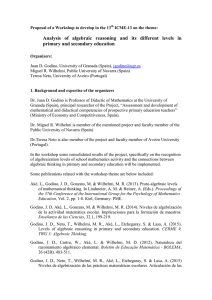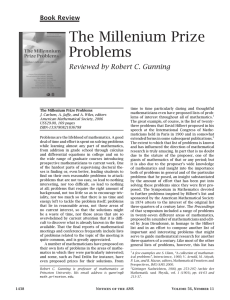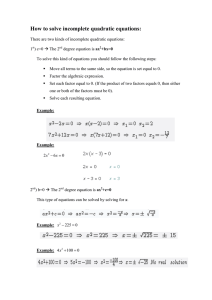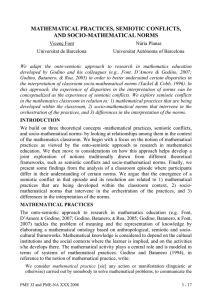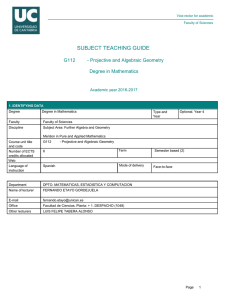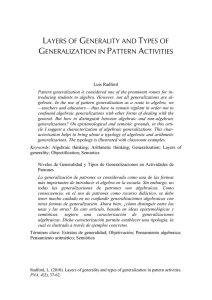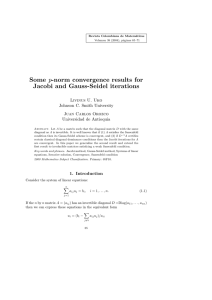levels of algebraic reasoning in primary and secondary education
Anuncio
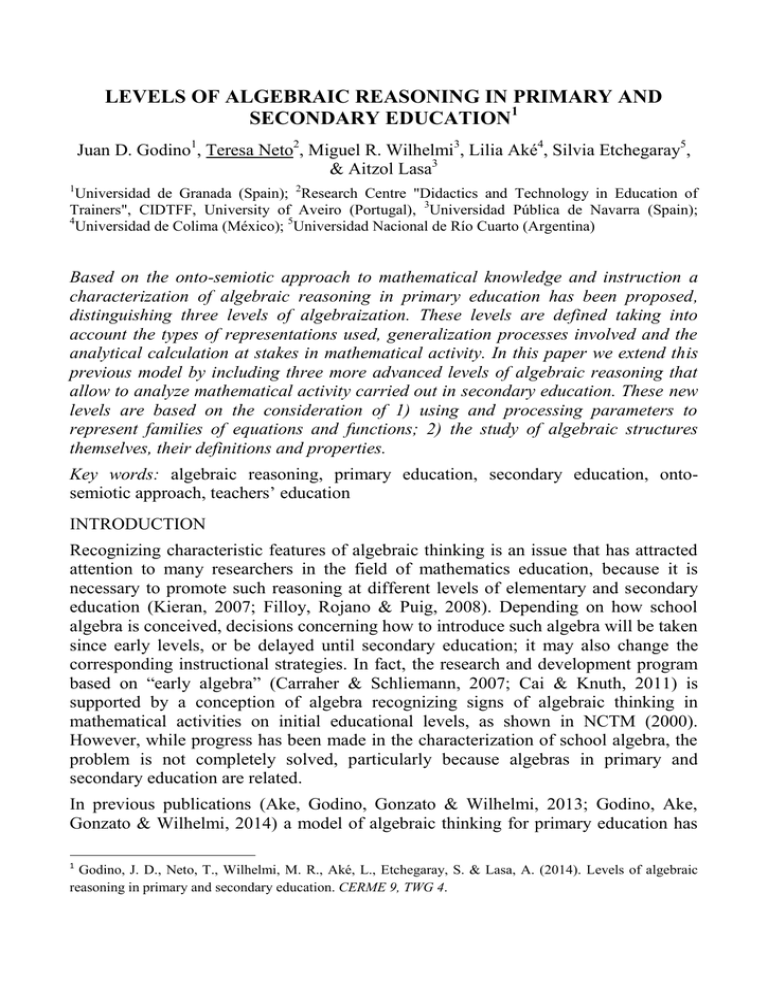
LEVELS OF ALGEBRAIC REASONING IN PRIMARY AND
SECONDARY EDUCATION1
Juan D. Godino1, Teresa Neto2, Miguel R. Wilhelmi3, Lilia Aké4, Silvia Etchegaray5,
& Aitzol Lasa3
1
Universidad de Granada (Spain); 2Research Centre "Didactics and Technology in Education of
Trainers", CIDTFF, University of Aveiro (Portugal), 3Universidad Pública de Navarra (Spain);
4
Universidad de Colima (México); 5Universidad Nacional de Río Cuarto (Argentina)
Based on the onto-semiotic approach to mathematical knowledge and instruction a
characterization of algebraic reasoning in primary education has been proposed,
distinguishing three levels of algebraization. These levels are defined taking into
account the types of representations used, generalization processes involved and the
analytical calculation at stakes in mathematical activity. In this paper we extend this
previous model by including three more advanced levels of algebraic reasoning that
allow to analyze mathematical activity carried out in secondary education. These new
levels are based on the consideration of 1) using and processing parameters to
represent families of equations and functions; 2) the study of algebraic structures
themselves, their definitions and properties.
Key words: algebraic reasoning, primary education, secondary education, ontosemiotic approach, teachers’ education
INTRODUCTION
Recognizing characteristic features of algebraic thinking is an issue that has attracted
attention to many researchers in the field of mathematics education, because it is
necessary to promote such reasoning at different levels of elementary and secondary
education (Kieran, 2007; Filloy, Rojano & Puig, 2008). Depending on how school
algebra is conceived, decisions concerning how to introduce such algebra will be taken
since early levels, or be delayed until secondary education; it may also change the
corresponding instructional strategies. In fact, the research and development program
based on “early algebra” (Carraher & Schliemann, 2007; Cai & Knuth, 2011) is
supported by a conception of algebra recognizing signs of algebraic thinking in
mathematical activities on initial educational levels, as shown in NCTM (2000).
However, while progress has been made in the characterization of school algebra, the
problem is not completely solved, particularly because algebras in primary and
secondary education are related.
In previous publications (Ake, Godino, Gonzato & Wilhelmi, 2013; Godino, Ake,
Gonzato & Wilhelmi, 2014) a model of algebraic thinking for primary education has
1
Godino, J. D., Neto, T., Wilhelmi, M. R., Aké, L., Etchegaray, S. & Lasa, A. (2014). Levels of algebraic
reasoning in primary and secondary education. CERME 9, TWG 4.
been proposed, with three distinguished levels of algebraic thinking. Furthermore,
criteria was stablished to delimit these algebraic levels from 0 (arithmetic nature of
mathematical activity) to 3 (clear algebraic activity), with two intermediate levels of
proto-algebraic activity. The criteria to define these levels are based on the type of
mathematical objects and processes involved in mathematical activity, according to
the onto-semiotic approach (OSA) of mathematical knowledge (Godino, Batanero and
Font, 2007). Algebraization levels are assigned to operative and discursive practices
performed by a mathematical subject (individual or epistemic) that solves a
mathematical task, rather than the task itself, which can be solved in different ways,
and may bring into play different algebraic activity.
In this paper, we extend that model of algebraization levels for mathematical activity
to secondary school, also supported by the onto-semiotic distinctions suggested by the
OSA, particularly in the presence, use and processing of parameters in functions and
equations. The work is organized in four sections. The following section summarizes
features of algebraic reasoning levels in elementary education; next, we define the
three new levels of algebraization, include some illustrative examples and connect
these levels to the presence of discontinuities in the onto-semiotic configurations
involved in mathematical practices.
LEVELS OF ALGEBRAIC REASONING IN PRIMARY EDUCATION
Table 1 summarizes the essential features of the three preliminary algebraization
levels described by Godino et al. (2014), completed by level 0 (absence of algebraic
characteristics). An example is also included to help to understand the distinction
among levels. In summary the definition of levels are based on the following ontosemiotic distinctions:
Presence of intensive algebraic objects (i.e., entities of general or indeterminate
character).
Transformations (operations) applied to these objects based on the application
of structural properties.
Type of used language.
Table 1: Characteristic features of elementary algebraic reasoning levels
Task: In a certain school, students either go by car or by walk. For every student who goes by car
there are 3 going by walk. If there are 212 students at that school, how many of them use each means
of transportation?
LEVELS OBJECTS
TRANSFORMATIONS
LANGUAGES
0
No intensive
Natural, numerical, iconic,
objects are
Operations are carried out with
gestural; symbols referring
involved.
extensive objects.
extensive objects or
In structural tasks
unknown data can take part.
unknown data can
be used.
Example of resolution:
1
2
3
For every 3 students who walk, there is 1 that goes by car. Hence, in every bunch of 4
students (3 + 1) there is 1 which goes by car (a fourth part). Thus, 50 out of 200 students
go by car and 3 out of 12 students would also go by car. Therefore, 53 students would go
by car and three times that amount, that is, 159, by walk.
In structural tasks In structural tasks relations and
Natural, numerical, iconic,
unknown data can properties of operations are applied.
gestural; symbols referring
be used.
In functional tasks calculation
to intensive recognized that
In functional tasks involve extensive objects.
can be used.
intensive objects
are recognized.
Example of resolution:
For every 4 students there are 3 which go by walk. We write out the following
proportion:
4 (children) ------> 3 go by walk
212 (children) ------> x go by walk
; x = 3 × 212/4 = 159.
Once we obtain the number of children who go by walk, the number of students going by
car is easily obtained, 212 - 159 = 53.
Indeterminate or
In structural tasks equations are of
Symbolic - literal, used to
variables are
the form Ax ± B =C.
refer the intensive
involved.
In functional tasks generality is
recognized, although linked
recognized but operations with
to the spatial, temporal and
variables are not carried out to get
contextual information.
canonical forms of expressions.
Example of resolution:
212=x + 3x
212 = 4x; x = 212 / 4; x = 53
53 children go by car and 212-53 = 159 by walk.
Indeterminate or
In structural tasks equations are of
Symbolic – literal; symbols
variables
the form Ax ± B =Cx ± D.
are used analytically,
intervene.
Operations with indeterminate or
without referring to
variables are carried out.
contextual information.
Resolution example:
x = Children going by car
y = Children going by walk
x+y = 212
x+3x = 212;
y = 3x
4x = 212; x = 212/4 = 53
The algebraization levels we propose are related to two aspects that Kaput (2008)
identifies as characteristic of algebraic reasoning, namely, algebra as:
a) Systematic symbolization of generalizations of regularities and constraints.
b) Syntactically guided reasoning and actions on generalizations expressed in
conventional symbolic systems.
Aspect a) is specified in our model as levels 1 and 2 of proto-algebraic reasoning,
while b) is associated with level 3, where algebra is already consolidated.
Obviously, these levels do not exhaust the processes of "algebraization". Instead, they
do refer the gradual enrichment of tools for solving problems with an increasing
degree of symbolization in other contexts of use. These processes, taken from the end
of primary school and junior secondary school, must evolve to higher levels of
algebraization.
LEVELS OF ALGEBRAIC REASONING IN SECONDARY EDUCATION
In this section, we extend the model of algebraization levels to secondary and high
school mathematical activity, recognizing three additional algebraization levels for
this educational stage.
Using parameters and its treatment can be a criterion for defining higher levels of
algebraization as it is linked to the presence of families of equations and functions, and
therefore imply new "layers" or levels of generality (Radford, 2011). The intervention
of parameters will be linked to the fourth and fifth level of algebraization, while the
study of specific algebraic structures leads to recognizing a sixth algebraization level
of mathematical activity.
Fourth level of algebraization: using parameters
The use of parameter for expressing equations and function families is indicative of a
higher level of algebraic reasoning, regarding the third algebraization level considered
by Ake et al. (2013), which is linked to the processes of "operate with a unknown or
variable." This is a “first encounter” with parameters and coefficient variables
involving discrimination of domain and range of the parametric function, i.e. the
function that assigns to each value of the parameter a specific function or equation. As
Ely and Adams (2012, p. 22) claim, “A significant conceptual shift must occur in
order for students to be comfortable using placeholders in algebraic expressions
rather than just numbers”.
Example 1: The linear function
In the algebraic expression, y = 2x, the literal symbols x and y are interpreted as
variables, as symbols that can take any value from the previously established number
set, usually R. The numerical values x and y co-vary one in terms of the other,
according to the rule laid down in the corresponding expression, in this case,
multiplying by 2 the value assigned to x. The x coefficient can be generalized to any
value within a certain domain, which is indicated by an expression of the type y = ax;
letter a intervenes as a parameter: it can take different values within a certain domain,
so that for each taken value a particular function is obtained. For example, for a = 2
we have y = 2x.
Thus, we could say that a parameter is a literal symbol involved in an expression with
other variables, such that for each particular value assigned to it, a function is
obtained. It is therefore a mean of expression of a functions family F = {f(x) =
ax/a R}, or more precisely, a family of functions family depending on the domain D
of definition of the functions f: FD = {f(x) = ax | a R; x D}.
The letter symbols x and y (f(x)) are indicative variables of a first level of generality,
whose domains of definition and range are the numeric sets in which they are defined.
The symbol a is also a variable, but with a second level of generality, whose domain
of definition could either be the same as before (D) or just another number set, and the
range of values is the family of functions FD.
Example 2: Quadratic equation
Parameters are used not only to express and operate with function families, but also
equation families (Ely and Adams, 2012). For example, ax2 + bx + c = 0 (a ≠ 0) is the
general expression for the quadratic equations family. There is only one unknown, x.
Letters a, b, c, usually considered as varying coefficients, take specific values within a
set of possible values (real numbers and a ≠ 0) to produce a particular equation.
It is said, therefore, that a parameter is a variable that is used with two or more other
variables to specify a family of functions or equations. For families of equations
commonly the parameter is named coefficient. In a way, the parameter plays the role
of independent variable in a function whose domain is the set in which the parameter
takes values and their rank is a set of functions. For each value assigned to the
parameter a function image is obtained. Therefore, the expression y = ax2+bx+c, is
not a function but a family of functions, though it is usually referred to as "the
quadratic function." It is an expression in which three parameters indicated by the
letters a, b, c are involved. Giving a particular value to each of the parameters a
specific quadratic function is obtained.
Example 3: General matrix with n rows and m columns
Matrixes are more than simple arithmetic objects, since the relative position of a
particular number in the box gives structured information. Furthermore, the study of
matrixes in secondary school is full of symbolic notation, because each element in a
cell on a general matrix has its own index, A = (aij)m,n, indicating row and column.
These indexes are parameters and, therefore, the discursive practice defining a matrix
belongs to a fourth algebraization level, even though the study of operations and
structural properties of matrixes could belong to a higher level, as seen in Figure 1.
Matrixes are numerical rectangular tables:
A=(a11 a12 a13…a1n; a21 a22 a23…a2n; a31 a32
a33…a3n; …; am1 am2 am3…amn). This matrix has
m rows and n columns. It has dimension mxn.
Elements aij are real numbers (aijeR). The matrix
below could be simplified as (aij)i=1,…m;j=1,…,n,
A(aij)m,n, (aij).
When m=n, the matrix is named square.
Two matrixes are identical when their dimensions are
equal and their elements agree one by one.
A=(aij)m,n, B=(bij)m,n; A=B iff aij=bij
The transpose of matrix A=(aij)m,n is a matrix
At=(aji)n,m where rows and columns have been
interchanged.
A matrix A is symmetric if At=A. A symmetric matrix
must be square.
Figure 1. Matrix (Colera and Oliveira, 2009, p.50)
This example suggests the possibility to analyze algebraization levels when working
with matrixes and when applying them in the resolution of equation systems.
Fifth level of algebraization: treatment parameters
We can link a higher level of algebraization to mathematical activity displayed when
analytical (syntactic) calculations are carried out in which one or more parameters are
involved. Operations with parameter involve greater semiotic complexity level, since
objects emerging from these systems of practices put at stake algebraic objects of the
previous level (equations or functions families).
Example 3: Obtaining the general formula for quadratic equations
We proceed by symbolic manipulation and successive equivalences. Assuming the
director coefficient a is not 0 (a 0) otherwise the equation would not be quadratic
we have:
b
c
b
c
ax2 + bx+ c = 0 Û x2 + x+ = 0 Û x2 + x = - Û
a
a
a
a
b
b2
c b2
b
b2
4ac b2
x2 + x+ 2 = - + 2 Û x2 + x+ 2 = - 2 + 2 Û
a
4a
a 4a
a
4a
4a 4a
æ
b ö b2 - 4ac
b
b2 - 4ac
b
b2 - 4ac -b± b2 - 4ac
Û
x
+
=
±
Û
x
=
±
=
ç x+ ÷ =
è 2a ø
4a2
2a
4a2
2a
2a
2a
2
Thus, in this case the structure of the solutions is written in terms of the coefficients
linked by rational operations (addition, subtraction, multiplication, division) and
square roots calculation.
Example 4: Geometric progressions
Defining the general term of a geometric progression (figure 2) is performed by
discursive practices in which two parameters, a1 (first term of the sequence) and r
(progression ratio) are involved. The sequence is a function whose domain is N and
range is R; therefore the parameters a1 and r define a family of functions (sequences),
so this discursive practice put at stake algebraization level 4. The statement and proof
of the property that states the sum of the first n terms of a geometric progression (r ≠
0) involves calculating with parameters, as shown in figure 1, so implying the level 5
of algebraization.
36.8 Finite Geometric Series
When we sum a known number of terms in a
geometric sequence, we get a finite geometric
series. We know that we can write out each term
of a geometric sequence in the general form:
n-1
an = a1 ・ r
where
• n is the index of the sequence;
• an is the nth-term of the sequence;
By simply adding together the first n terms, we are
actually writing out the series
2
n-2
n−1
Sn = a1 + a1 r + a1 r + . . . + a1 r + a1 r
We may multiply the above equation by r on both
sides, giving us
2
3
n−1
n
rSn = a1r + a1r + a1r + . . . + a1r + a1r
....
Dividing by (r − 1) on both sides, we arrive at the
general form of a geometric series:
• a1 is the first term;
• r is the common ratio (the ratio of any term to
the previous term).
Figure 2: Finite geometric series (Free High School Science Texts, Mathematics
Grades 10 – 12, p. 469, 2008)
Sixth level of algebraization
The introduction of certain algebraic structures (such as vector spaces, or groups) and
the study of function algebra (addition, subtraction, division, multiplication, and
composition) start at high school, bringing into play algebraic objects and processes of
higher level of onto-semiotic complexity than those considered at level five. It may be
useful, therefore, to characterize a sixth algebraization level that should help us to
focus our attention on the specific nature of the mathematical activity involved. High
school books include texts and activities corresponding to this sixth algebraization
level:
Example 5: Vector space
Figure 3 shows a general formulation of the algebraic structure of a vector space. This
is a first encounter with the algebraic structure of vector spaces which brings into play
a set of mathematical objects (vectors) on which operations satisfying a set of specific
properties are defined. This requires an initial "structural study" of vectors, since in
this type of (axiomatic) presentation properties of vector addition and multiplication of
vector by numbers have to be established.
The vector idea as an arrow leads to vector
space: sets of vectors among some operations
satisfying certain properties are defined. But
there are other mathematic entities with the
same operations and properties. So, the vector
space definition is much broader and open than
collections of “arrows”. We have a set, V,
among whose elements (called vectors) there
are two operations defined:
SUM OF TWO ELEMENTS OF V: if
,
SUM OF VECTORS
ASSOCIATIVE
COMMUTATIVE
NULL VECTOR
It is a vector called
such that if
fulfils:
OPOSITE
ECTOR
All
has its opposite
:
MULTIPLYING A VECTOR BY A NUMBER
ASSOCIATIVE
then
PRODUCT BY A REAL NUMBER: if aϵR and
uϵV, then a.uϵV
If (V, +, .) satisfies the following properties then
is a vector space on R.
DISTRIBUTIVE I
DISTRIBUTIVE II
PRODUCT BY 1
If
then 1.
Figure 3: Vector space (Colera & Oliveira, 2009, p. 62)
Example 6: Composition of functions
In Figure 4 the notion of function is put into play in all its generality, replacing a
particular family of functions by any function. Operations are carried out over
functions to produce new functions whose properties will be studied in general. For
example, statements such as “the composition of functions is not commutative” would
arise. In fact, a set of functions (polynomials, for example) satisfying certain
operations (addition, multiplication, etc.) is an "algebra".
It is possible to combine two functions by adding, subtracting, multiplying or dividing two given
functions.
There is another way to combine two functions to create a new function. It is called composition
of two functions. It is a process through which we will substitute an entire function into another
function.
First let’s get acquainted with the notation that is used for composition of functions. When we
want to find the composition of two functions we use the notation
.
Another way to write this is
. This is probably the more practical notation although the
first notation is what appears most often in books.
Figure 4: Composition of functions (AlgebraLAB. Project Manager. Mainland High
School)
Algebraization levels and onto-semiotic discontinuities
Algebraization levels are basically levels of generality, combined with the use of
various registers of semiotic representation (RSR), theirs transformations and
conversions (Duval, 1995). Under the OSA these levels can be characterized by the
presence of different types of onto-semiotic configurations (Godino, Font, Wilhelmi
and Lurduy, 2011) which involve practices, objects and processes implying new levels
of generality or syntactic calculus, supported by symbolic representations of the
corresponding objects. This furthermore implies the intervention of unitization,
materialization and reification processes involved in the generalization and
representation processes (Godino et al., 2014).
The proposal of considering algebraization levels of mathematical activity can help
raise awareness of gaps or discontinuities within the sequence of configurations on
epistemic trajectories of the corresponding processes of mathematical study (Godino,
Contreras and Font, 2006). These gaps refer to the use of different registers of
semiotic representation, their treatment and conversion, as well as the intervention
and establishment of relations between conceptual, propositional, procedural and
argumentative objects of greater generality (intensive objects emerging from other
intensive). In other words, these gaps can be explained by analyzing how, numericaliconic and analytical - algebraic onto-semiotic configurations involved are articulated,
and not only for the treatment or conversion of RSR.
Recognizing algebraization levels can be helpful to analyze the articulation of these
onto-semiotic configurations. The identification of objects, processes and meanings
involving access to different levels of algebraization allows the design of operative,
normative and discursive practices aimed at learning progression. This progression
will involve coping with discontinuities in levels of generality, representation,
calculation and construction of algebraic objects in different educational institutions.
SYNTHESIS AND IMPLICATIONS FOR TEACHER EDUCATION
In this work we have completed the work started in Ake et al. (2013) and Godino et al.
(2014) on the identification of algebraization levels of mathematical activity in
primary education, including three new levels that characterize secondary
mathematics. As a summary we propose the following six levels of algebraic thinking
in primary and secondary education (along with level 0, indicating absence of
algebraization):
Level 0: Operations with particular objects using natural, numerical, iconic, gestural
languages are carried out.
Level 1: First encounter with the "generic number", the algebraic structure properties
of N and the algebraic equality (equivalence). That is, relational thinking.
Level 2: First encounter with the alphanumeric representation of functions and
equations and simplifying expressions.
Level 3: First encounter with the treatment of unknowns and variables using structural
properties (cancellation, replacement, etc.) and the algebraic and functional modeling.
Level 4: First encounter with the use of parameters in functions and variable
coefficients, that is, with the expression of families of equations and functions, which
are second order intensive objects.
Level 5: First encounter with the joint treatment of unknowns, variables and
parameters as well as the structure of the solution emerging from the parameter
treatment.
Level 6: First encounter with the study of algebraic structures themselves, their
definitions and structural properties.
These algebraic reasoning levels have implications for teacher training, both in
primary and secondary education. It is not enough to develop curriculum proposals
(NCTM, 2000) including algebra from the earliest levels of education; the teacher is
required to act as the main agent of change in the introduction and development of
algebraic reasoning in elementary classrooms, and its progression in secondary
education. Reflexing on the recognition of objects and processes of algebraic thinking
can help identify features of mathematical practices on which teachers can intervene to
gradually increase the algebraization levels of students’ mathematical activity.
Recognizing algebraization levels 4, 5 and 6 by secondary school teachers, along with
its articulation with the previous levels, can help raise awareness of the gaps or ontosemiotic discontinuities which may occur when carrying out tasks proposed to
students.
Acknowledgement
The research reported in this article was carried out as part of the following projects:
EDU2012-31869 and EDU2013-41141-P (Ministry of Economy and Competitiveness,
Spain)
REFERENCES
Aké, L. Godino, J. D., Gonzato, M. & Wilhelmi, M. R. (2013). Proto-algebraic levels of
mathematical thinking. In Lindmeier, A. M. & Heinze, A. (Eds.). Proceedings of the 37th
Conference of the International Group for the Psychology of Mathematics Education,
Vol. 2, pp. 1-8. Kiel, Germany: PME.
Cai, J. & Knuth, E. (2011). Early algebraization. A global dialogue from multiple
perspectives. Berlin: Springer-Verlag.
Carraher, D. W. & Schliemann, A. L. (2007). Early algebra and algebraic reasoning. En: F.
Lester (Ed.), Second Handbook of Research on Mathematics Teaching and Learning
(Vol. 2, 669-705). Charlotte, N.C: Information Age Publishing, Inc. y NCTM.
Colera, J. & Oliveira, M. J. (2009). Matemáticas II. Bachillerato. Madrid: Anaya.
Colera, J., Oliveira, M. J., García, R. & Santaella, E. (2008). Matemáticas I. Bachillerato.
Madrid: Anaya.
Duval, R. (1995). Sémiosis et penseé humaine. Berna: Peter Lang.
Ely, R., & Adams, A. (2012). Unknown, placeholder, or variable: what is x? Mathematics
Education Research Journal, 24 (1), 199–38.
Filloy, E., Puig, L. & Rojano, T. (2008). Educational algebra. A theoretical and empirical
approach. New York: Springer.
Font, V. & Contreras, A. (2008).The problem of the particular and its relation to the general
in mathematics education. Educational Studies in Mathematics, 69, 33-52.
Font, V., Godino, J. D., Planas, N. & Acevedo, J. I. (2010). The object metaphor and
sinecdoque in mathematics classroom discourse. For the Learning of Mathematics, 30,
15-19.
Godino, J. D., Batanero, C. & Font, V. (2007). The onto-semiotic approach to research in
mathematics education. ZDM. The International Journal on Mathematics Education, 39
(1-2), 127-135.
Godino, J. D., Contreras, A. & Font, V. (2006). Análisis de procesos de instrucción basado
en el enfoque ontológico-semiótico de la cognición matemática. Recherches en
Didactiques des Mathématiques, 26 (1), 39-88.
Godino, J. D., Font, V., Wilhelmi, M. R. & Lurduy, O. (2011). Why is the learning of
elementary arithmetic concepts difficult? Semiotic tools for understanding the nature of
mathematical objects. Educational Studies Mathematics, 77(2), 247-265.
Godino, J. D. Aké, L., Gonzato, M. & Wilhelmi, M. R. (2014).Niveles de algebrización de la
actividad matemática escolar. Implicaciones para la formación de maestros. Enseñanza
de las Ciencias, 32.1, 199-219.
Kaput, J. (2008). What is algebra? What is algebraic reasoning? En J. Kaput, D. W. Carraher,
y M. L. Blanton (Eds), Algebra in the early grades (pp. 5-17). New York: Routledge.
Kieran, K. (2007). Learning and teaching algebra at the middle school through college levels.
Building meaning for symbols and their manipulation. En, F. Lester (Ed.), Second
Handbook of Research on Mathematics Teaching and Learning (Vol. 2, 707-762).
Charlotte, N.C: Information Age Publishing, Inc. y NCTM.
National Council of Teachers of Mathematics (NCTM) (2000). Principles and standards for
school mathematics.Reston, VA: Author.
